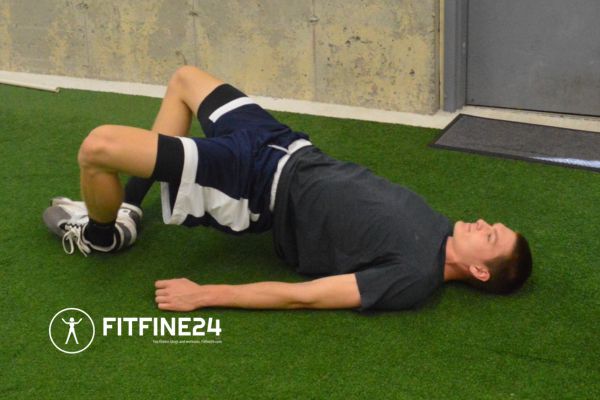
One of the most useful exercises out there that is designed to work the lower body muscles, especially the glutes, hamstrings, and core, is a glute bridge workout. Glute bridge targets are: to increase one’s athletic performance, correct posture, treat back pain, or make one’s body more attractive. In this article, we will discuss what a glute bridge is, what benefits this exercise can provide, and how to do it right as well as how to combine it with other variations of glute bridge workouts.
What is a Glute Bridge workout?
A glute bridge is a calisthenics exercise intended primarily for the glute muscles but also works other muscle groups such as the hamstrings, core, and lower back. This exercise requires you to lie on your back and raise your hips off the floor until your body makes a straight line from your shoulders to your knees. It does not require any equipment making it easy for both novices and experienced sportsmen.
The Merits of Glute Bridge workouts
Glute bridge workouts are very popular and are part of most fitness exercises because of their benefits. Below are some of the gains that you will get once you include the exercise of Glute bridge workouts in your workouts:
Strengthens the Glutes: The main purpose of Glute bridge workouts is to activate as well as strengthen the gluteal muscles. Sufficient power is very beneficial as far as sports activities are concerned, posture and chances of accidents can be reduced as well.
Improves Core Stability: Glute bridge workouts are a movement that requires you to generate some stabilizing muscles for the duration of the exercise to stay in control. This helps in developing the core muscles of the body.
Enhances Posture: Having weak glutes and hamstrings contributes to poor posture and even chronic lower back discomfort. Glute bridge workouts target those muscles and therefore posture is improved and low back pain is prevented.
Reduction of Lower Back Pain: The lower back pain can be relieved with the help of the glute bridge as it strengthens the surrounding supporting structures. When carried out appropriately, it helps reduce excessive pressure from the lower back region and improves spinal posture as well.
Versatility:Glute bridge workouts are efficient exercises that can be performed anywhere, be it at home, gym, or while on the move. They do not call for the use of any equipment, however, this can be easily altered with the use of resistance bands, weights, or other tools to heighten the intensity.
Increases Hip Mobility: Also, these bridges serve to enhance hip-flexing abilities which in turn improves the ostensible range of motion and flexibility or mobility of the hamstrings and glutes. This can be useful in athletes, runners, and anyone who seeks to improve patterns of movement.
How To Perform Basic Glute Bridge Workouts
When executing a glute bridge, specific parts of the body are being used and in the right form, this is very important; especially if you are to get as many benefits from the move as possible while minimizing the risk of injury, you should follow these steps on how to get it right when doing a perfect glute bridge
How To Perform Basic Glute Bridge Workouts

Starting Position: Position yourself on your back with knees bent at a right angle and feet flat on the floor with feet hip apart. Arms are placed alongside the body with the palms facing down relaxed.
Engage Your Core: This is a quick abdominal contraction intended to get your core ready and engage your deep abdominals by drawing your navel in towards your spine. It helps to prevent excessive shifting of the torso during the exercise.
Lift Your Hips: While driving your heels into the ground, raise your hips off the floor in the direction of the ceiling. By the end of the range, the trunk and legs abdominals will be extending and aligned: from shoulders to knees during the top position of the movement.
Squeeze Your Glutes: At the top of the bridge contraction, tighten your glutes and hold for a second. Ensure that there is no arch on your lower back and the core remains tight.
Lower Slowly: With the control of the comedian, bring your hips again to the starting position, only do not allow them to touch the ground. Do the same for the desired number of repetitions.
Common Mistakes to Avoid
To expatriate all the benefits of the glute bridge workout, it’s best to get rid of these common workout blunders:
Arching of the Lumbar Spine:Allowing the lumbar spine to overly extend in the topmost position is one of the typical exercise mistakes. It is quite unpleasant and increases tendencies in lumbar spine stressing which should not be. Focus instead on keeping the core tight and form a straight line through shoulder to knee range.
Using Momentum:There is another mistake that people make where they hoist the hips by brute force instead of activating and using the glutes and hamstrings. Thus focus on going slowly, with full control which guarantees that the action performed came from the glutes and not by speed.
Incorrect Foot Placement:A common mistake is to let the feet go too distant from the body. This causes the exercise to be centered on the hamstrings, losing the tension on the glutes. Ensure that the legs are bent, feet apart to the width of the hips, and close enough to the body to be able to feel the buttock.
Glute Bridge Variations For Further Repetition
Regardless of the progress towards glute building, at some point, the glute bridge may become boring. To remedy any boredom with this primary exercise, try some of the following variants to help:
Single-Leg Glute Bridge
The single-leg version makes the exercise harder by performing the glute bridge using one leg. This exercise increases the complexity of the movement, as it includes balance and stabilization of the core and the muscles.

How to Perform: Position yourself into the general glute bridge position. Raise one leg straight, off the ground, or hold it with a bend. With the heel of the other foot, exert force and extend your hips upward, then return. Alternate between each leg and repeat.
Weighted Glute bridge workouts
Variations of the basic exercise “bridges” by adding additional weight, will increase strength and muscle gain more than usual. A barbell, dumbbell, or any resistance band may be used to add extra weight.
How to Perform: Place any type of added weight (barbell, dumbbell, etc.) over your hips and secure this with your hands. Carry out the glute bridge in the usual manner whilst maintaining balance on the added weight at all times.
Glute Bridge with Resistance Bands
Alternatively, the exercise can be made more challenging when using a resistance band on the thighs as it adds resistance particularly targeting the glutes and outer thighs.
How to Perform:Place the band around your thighs about 2-3 inches above the knees. As you do the glute bridge, push your knees out against the band.
Hip Thrust
The hip thrust is a more advanced version of the glute bridge as it allows for an increased range of motion and more activation of the glute muscles. Usually performed with the upper back on a bench and the weight on the hips.
How to Perform:Position yourself in a sitting position with your upper back resting against the bench and feet flat on the ground. Position a weight on the anterior part of your pelvic region. Then drive through your heels and raise your hips into a straight line from shoulders to knees. Get back to the original position and repeat constipation.
Sample Glute Bridge Workout Routine
Below is a sample glute bridge workout routine that can be added to your current workout regimen for strengthening the glutes, hamstrings, and core area:

Warm-Up:Perform about 5 to 10 minutes of light cardio (jogging, cycling, or dynamic movements) to allow the body to get warmed up.
Exercise 1: Glute Bridge – 3 sets of 15-20 reps
Exercise 2: Unilateral glute bridge – 3 or 4 sets of 10-12 per leg
Exercise 3: Glute Bridge with Bands – 3 sets of 15
Exercise 4: Glute Bridge with weighted plate – 3 × 12 – 15
Cool Down: It is important to stretch after exercise. Stretch for 5 minutes concentrating on the glutes, hamstrings, and hip flexors.
Tips for Incorporating Glute Bridges into Your Routine
How Often:You should aim to do glute bridges at least 2 -3 times a week to get maximum results.
Combination with Other Moves:Glute bridges are particularly useful in terms of being the last exercise performed to conclude a workout comprised of lower body moves (composition).
Progression: You may begin with the simplest glute bridge and progress step by step to advanced glute bridge variations as you acquire power and confidence.
Conclusion
The glute bridge can be described as one of the most efficient exercises that target the lower body muscles. Whether the goal is to enhance one’s sporting ability lessen back discomfort or get into better shape, putting in glute bridges will help one achieve these objectives. Glute bridges require very little equipment and so many variations can be made; thus chances of this exercise being tedious are very slim.
As long as one maintains the correct technique and moves to an advanced level in stages, this exercise’s optimum effects can be rediscovered, with a stronger body being the result too. If you want to see the difference, then make sure you include glute bridges in your workout regime right now and turn your body into what you want to have!

